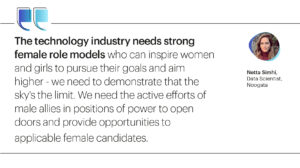Statistics for women in STEM (Science, Technology, Engineering and Mathematics) vary across specific industries and regions, but without doubt, women remain underrepresented, particularly at a leadership level. Eurostat figures, for example, suggest that just 5% of leadership positions in the technology industry are held by women. According to the Boston Consulting group, in the US, women hold less than ⅓ of leadership positions in tech and yet, a higher proportion of female leaders leads to increased profitability.
On International Women’s Day this year, we asked some of the female leaders and executives within Team8’s portfolio companies for their thoughts on being a woman in technology, how to increase the number of women in technology and if they had any advice for the rest of us or had been given any great advice that helped them. Here’s what they had to say:

Amit Rosenwaks, Director of Business Development, Talon Cyber Security
I believe that there’s a lot of work to be done in both the short- and long-term to improve opportunities for women in technology. In the short term, it’s essential that the number of women in tech, including in leadership positions and on boards, must be measured as part of a company’s KPIs, similarly to metrics such as ARR, growth and HC. It would be helpful too if venture capital firms included these metrics in their decision making when investing in early stage companies. Genuinely flexible working environments will also attract more women to tech companies.
Over the longer term, education for girls, starting at kindergarten and going all the way through to university should integrate programs that encourage women to take part in science subjects.
The best advice I ever received was not to leave your network to chance. Studies show that women network less than men, and often avoid it due to self-imposed barriers. A network can be very powerful – when looking for a job, a mentor, advice or even just sharing knowledge. It must be a priority.
My advice to others is to surround yourself with ambitious women!

Daniela Kolton, Sales & Partner Operations, Claroty
If we want more women in technology, we absolutely have to include education in STEM for girls from a very young age. For me, my biggest challenge was needing to learn the system without any prior knowledge or training and it has meant I’ve never had a soft landing professionally.
The best advice I’ve had and would give is “Dare!” And if you fail, dare again, be patient and trust yourself. You can do this if you set your mind to it.

Erika Alter, Head of Marketing, Fundguard
While the number of women in technology is increasing, albeit slowly, there’s still a lack of women in leadership roles. Technology organizations must not only recruit more women, they must also be diligent about recognizing the talented women already in their organizations and promoting them to leadership positions. This, in turn, will attract more women to leadership positions.
My biggest challenge in technology has been imposter syndrome – moments of insecurity throughout my career when taking on new responsibilities and roles. To manage this, I turn to my group of industry peers, mentors and friends who have always been my supporters. There’s nothing like a squad of successful women cheering you on and reminding you of your achievements. Every experience brings a learning curve, but it’s past experiences and accomplishments that prepare me for new opportunities.
I have had three key pieces of advice that have remained relevant throughout my career: Be your own marketer, own your mistakes, let the team be the talent. Ultimately, you need to build strong relationships but it’s up to you to amplify your own contributions and those of your team, and, when necessary, to admit, own and rectify any mistakes. And as you grow your career, to be a leader, you have to trust the talent and skills of your team to get the job done and to grow and innovate.

Fleur Sohtz, Chief Revenue Officer and GM Americas, Noogata
Increasing women in technology requires an intrinsic shift in the way we aim to attract and recruit women – it’s impossible without looking beyond the traditional networks that tend to be very male – whether that’s in Israel, the technology industry or in business generally.
Every day is a challenge because every day I look different to everyone else at the tables I sit at. This has been true throughout my career and today, as one of the few women at this level and with these responsibilities, it’s even more obvious. As a woman, I have to be careful that being deadline and objective-oriented isn’t perceived as too demanding or aggressive. Today, I’ve learnt to use my voice for myself, the people on my team and the people in my network and to make sure that everyone is heard.
The best advice I ever received was to “Always focus on the goal”. I see this as “Deliver, deliver, deliver”, often above and beyond what is expected (which is something women have to do anyway). I always focus on the goals of the company and prioritize the company’s success because if you achieve this, personal growth will follow.

Heather Eng, Head Of Solutions, Noogata
Women need to take a seat at the table, even if they don’t feel ready or think they deserve it yet. The reality is that women often don’t feel “ready” because we’re our own worst critics. But don’t wait to be asked – take a seat because a seat at the table today means you’re more likely to be at the head of the table down the road. It might be uncomfortable at first, but it’s a muscle that needs to be exercised like any other.
The best advice I got was basically, “it’s better to beg for forgiveness than ask for permission.” In a practical sense, this means women need to propose solutions or ideas, even when we aren’t asked. Act decisively and, if you’re wrong, don’t dwell on it – chalk it up to experience and move on.

Jody Padar, Head of Tax Strategy & Evangelism, April
I had a very non-linear career path. As a young mother, I left my job at a CPA firm because there just didn’t seem to be the same opportunities for me if I wasn’t working the 60 hour weeks others were. I wanted to find different tools and methods to work differently, and while I’m often called “innovative” now, back then I was just “crazy”! I wanted to use automation to reduce the number of hours CPAs worked and improve their lives.
My advice is to figure out the “big idea” that will drive you and give you the energy to keep moving forward. It has to be bigger than your job or the company itself because that will make you keep trying even when it doesn’t seem possible and will stop other people’s opinions from affecting your path. The other piece of advice I think is crucial came from my dad – “Go find your own clients”. It’s really hard because you have to learn how to define your value and sell yourself and, as a technical specialist, that’s not a skill that I had been taught. But if you can’t sell, you can’t be in business.

Netta Simhi, Data Scientist, Noogata
The technology industry needs strong female role models who can inspire women and girls to pursue their goals and aim higher – we need to demonstrate that the sky is the limit. We need the active efforts of male allies in positions of power to open doors and provide opportunities to applicable female candidates.

Nina Gouas France & Southern Europe Channel Director, Claroty
The biggest challenge I found entering the tech industry is that it doesn’t always let outsiders in. I had to do extensive networking and work hard to convince people that my skills would add value to the industry.
This is part of a bigger problem of a lack of female role models tech which makes women less attracted to it. Women simply aren’t visible enough in this industry and much more needs to be done to give women the visibility to inspire others.
The best advice I received was to never give up and that everything is possible. Women can create their own limits if they believe this is a reality. In my case, I wanted to work in cyber and I wasn’t willing to give up on that. Along the way I also met some pretty amazing people who were always ready to help.

Rina Shainski, Chairwoman, Co-founder at Duality Technologies
I’d like to see much more gender balance in startups, tech companies and venture capital firms in the future. For this vision to become a reality it is necessary to foster ecosystems and networks of successful female executives that will serve as inspiring role-models, empower and mentor women aspiring to become successful technology entrepreneurs and technology executives.
I have a deep passion for innovation and technology which I think has worked well for me in my career. But there are additional elements that are necessary to increase the chances of success when building a new company – The team! And the ecosystem of mentors, supporters and role-models – it is critically important to have a strong supporting ecosystem when embarking on the daring endeavor of building a new technology company.
(Read more about Rina’s thoughts here.)
Anonymous
To attract more women to tech, we need to change the workplace culture. All those values that are considered “masculine” such as aggressiveness and competitiveness. There’s room for workplaces to bring more “feminine” values such as reconciliation and people relations. To put these in place, office routines need to be changed such as how discussions take place, and increasing the ability to balance work and family life. Achieving this will make women more comfortable, attracting more to the industry and, as importantly, ensuring they stay.





